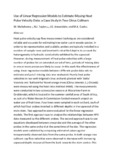Please use this identifier to cite or link to this item:
https://cris.library.msu.ac.zw//handle/11408/3832Full metadata record
| DC Field | Value | Language |
|---|---|---|
| dc.contributor.author | Mahohoma, W | - |
| dc.contributor.author | Taylor, N.J | - |
| dc.contributor.author | Annandale, J.G | - |
| dc.contributor.author | Gush, M.B | - |
| dc.date.accessioned | 2020-10-20T07:49:23Z | - |
| dc.date.available | 2020-10-20T07:49:23Z | - |
| dc.date.issued | 2013 | - |
| dc.identifier.uri | https://www.researchgate.net/publication/285123604_Use_of_linear_regression_models_to_estimate_missing_Heat_pulse_velocity_data_A_case_study_in_two_citrus_cultivars/link/57d96a5b08ae6399a39ad3c9/download | - |
| dc.identifier.uri | http://hdl.handle.net/11408/3832 | - |
| dc.description.abstract | Heat pulse velocity sap flow measurement techniques are considered reliable and accurate for estimating tree water use in woody species. In order to be representative and scalable, probes are typically installed in a number of sample trees and inserted to stratified depths to account for heterogeneity in hydraulic conductivity exhibited by the sapwood. However, during measurement of heat pulse velocities with a large number of probes for an extended period of time, periods of missing data in one or more probes are likely to occur. In this work the effectiveness of using linear regression models between different probe data sets to estimate and patch missing data was evaluated. Hourly heat pulse velocities in two well-irrigated citrus orchards planted with ‘Delta’ Valencia and ‘Bahianinha’ Navel orange trees [Citrus sinensis (L.) Osbeck] were measured using the heat ratio method (HRM). The measurements were conducted in two consecutive seasons at Moosrivier Farm in Groblersdal, which is located in the summer rainfall area of South Africa, as part of a Water Research Commission funded research project on water use of fruit trees. Four trees were sampled in each orchard, each of which had four probes inserted to different depths in the sapwood of the main stem. Two approaches were evaluated for the linear regression models. The first approach was to analyse the relationships between HPV data measured by the different probes. The second approach was to use equations developed between one probe and the average of the other probes in the same orchard at the same time of the day. The regression models were validated by comparing estimated values against independently observed data from the same probe. In both orange tree cultivars sap flow velocities were observed to decrease with increasing sapwood depth, measured from the bark towards the stem centre. This emphasizes the need to use multiple sensors to accurately estimate water use of individual trees when using sap flow measurement techniques. Linear regression models can be used to effectively estimate missing data when long term sap flow measurements using multiple probes are conducted in citrus trees. | en_US |
| dc.language.iso | en | en_US |
| dc.relation.ispartofseries | Acta horticulturae;September 2013 | - |
| dc.subject | citrus | en_US |
| dc.subject | heat ratio method | en_US |
| dc.subject | heat pulse velocity | en_US |
| dc.title | Use of linear regression models to estimate missing heat pulse velocity data: a case study in two citrus cultivars | en_US |
| dc.type | Article | en_US |
| item.fulltext | With Fulltext | - |
| item.openairecristype | http://purl.org/coar/resource_type/c_18cf | - |
| item.openairetype | Article | - |
| item.cerifentitytype | Publications | - |
| item.languageiso639-1 | en | - |
| item.grantfulltext | open | - |
| Appears in Collections: | Research Papers | |
Files in This Item:
| File | Description | Size | Format | |
|---|---|---|---|---|
| Use of Linear Regression Models to Estimate Missing Heat Pulse Velocity Data.pdf | Abstract | 99.15 kB | Adobe PDF |  View/Open |
Items in MSUIR are protected by copyright, with all rights reserved, unless otherwise indicated.



